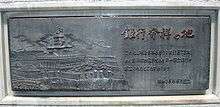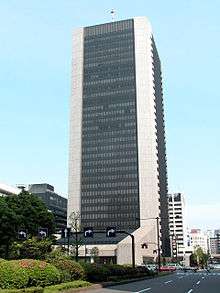Dai-Ichi Kangyo Bank
 | |
| Public KK (TYO: 8311) | |
| Industry | Bank |
| Fate | Merged with Fuji Bank and the Industrial Bank of Japan in 2000 |
| Predecessor |
Dai-ichi Bank (1873-1971) Nippon Kangyo Bank (1897-1971) |
| Successor | Mizuho Financial Group |
| Founded | 1971 |
| Headquarters | Tokyo, Japan |
Key people | Shibusawa Eiichi, Founder |
Number of employees | 14,714 (2001) |
| Website | www.dkb.co.jp |
The Dai-ichi Kangyo Bank, Limited (株式会社第一勧業銀行 Kabushiki-gaisha Dai-ichi Kangyō Ginkō), abbreviated as DKB (第一勧銀 Dai'ichi Kangin), was one of the largest banks in the world during the latter half of the 20th century.[1] Dai-Ichi Kangyo Bank was created in 1971 by a consortium of two banks: Dai-Ichi Bank of Japan's oldest bank. It weighed Japanese banknotes up to 1883. Nippon Kangyo bank, in turn, was a state financial institution that granted long-term loans to industry and agriculture. It combined with Fuji Bank and the Industrial Bank of Japan in 2000 to form Mizuho Financial Group.
In 2002, DKB's corporate & investment banking division was transferred to Mizuho Corporate Bank and retail banking division to Mizuho Bank severally.
History
Dai-ichi Bank

The Dai-ichi Bank, Ltd. (株式会社第一銀行 Kabushiki-gaisha Dai'ichi Ginkō), originally Dai-Ichi Kokuritsu Bank (lit. First National Bank) was literally the first bank and the first joint stock company ever to be established in Japan. Established by an industrialist Shibusawa Eiichi in 1873, it was originally empowered to issue banknotes, until the Bank of Japan assumed this function in 1883. Subsequently, it became a purely commercial bank based in Tokyo.
In 1884 Dai-ichi Bank made a deal with the Joseon Dynasty to make Dai-ichi Bank Korea Branch the monopoly agent of tariff management for Choson. In subsequent years Dai-ichi began issuing banknotes called “Dai-ichi Bank Token” in Korea, and became the de facto central bank of Korea. Following the Japan-Korea Protectorate Treaty of 1904, however, Dai-ichi was deprived of its privileges in Korea by the new colonial government, and reverted to being a conventional bank.
In 1943 Dai-ichi Bank and Mitsui Bank, a Mitsui zaibatsu company, merged to form Teikoku Bank (lit. Imperial Bank of Japan). Teikoku Bank was the largest bank in Japan in terms of assets when it was inaugurated. Teikoku Bank, however, couldn't expand its business freely owing to Japan being at World War II. Furthermore, former Dai-ichi employees and Mitsui employees didn't get along well together because of the difference of the two banks' corporate culture. As a result of its deteriorating business performance, Teikoku Bank was divided into two banks, the new Dai-ichi Bank and the new Teikoku Bank in 1948.
The new Teikoku Bank was renamed Mitsui Bank in 1954. It merged with Taiyo Kobe Bank to form Sakura Bank in 1990. Sakura Bank merged with The Sumitomo Bank in 2001 and is now Sumitomo Mitsui Banking Corporation.
Nippon Kangyo Bank
The Nippon Kangyo Bank, Ltd. (株式会社日本勧業銀行 Kabushiki-gaisha Nippon Kangyō Ginkō, lit. Japan Bank for Encouragement of Industry) was founded in 1897 as a governmental institution providing long-term light industrial and agricultural loans under the Nippon Kangyo Bank Act of 1896. The Industrial Bank of Japan was also founded in 1902, providing long-term heavy industrial loans. Nippon Kangyo Bank had offices only in Tokyo and Osaka, leaving nationwide local services in the charge of its subsidiary Noko Bank (lit. Agricultural and Industrial Bank). Noko Banks were established in each prefecture, except for Hokkaidō (see Hokkaido Takushoku Bank).
In order to provide long-term loans, the bank's source of funds was not deposits but debt securities. The bank was also authorized to issue premium-bearing debentures. The bank financed, however, landlords and partnerships, and there were little money to go around individual farmers. In 1911 the Nippon Kangyo Bank act was amended so that Nippon Kangyo Bank could handle deposit accounts and offer short-term finance. In the latter of Taishō period the bank embarked on real estate investments, while Noko Banks were absorbed into Nippon Kangyo Bank one after another. The bank dramatically increased its scale of operations.
During World War II, Nippon Kangyo Bank was the lead management underwriter of war bonds for Japanese government. In reality, the war bond by Nippon Kangyo Bank was a lottery rather than a bond. Today's Japanese lottery Takarakuji has its origin in this war bond.
After World War II, Nippon Kangyo Bank was privatized and became a commercial bank following the Nippon Kangyo Bank Repeal Act of 1950. The long-term banking division of Nippon Kangyo Bank was transferred to newly established Long-Term Credit Bank of Japan. The bank became popular among the public with the new rose logo, mascot named Nobara-chan (lit. Rose-chan) and advertising slogan “Rose's NKB” (「ばらの勧銀」 Bara no Kangin).
Merger
In 1971 Dai-ichi Bank and Nippon Kangyo Bank merged to form the Dai-ichi Kangyo Bank, Limited (“DKB”). DKB surpassed longtime leader the Fuji Bank as the Japanese largest bank measured by assets and deposit market share. DKB formed DKB Group (also known as Dai-ichi Kangyo Group), the largest Japanese keiretsu in terms of the number of associated companies, and became the central bank of DKB Group.
Taking over Nippon Kangyo and Noko's operation, DKB was the sole trustee of Takarakuji lottery and was the only bank to have branches in every prefecture in Japan.
DKB executives worried about recurrence of the problem in Teikoku Bank period that former two banks' employees were on bad terms each other. Therefore, they were particular about “a merger of equals”. DKB's board of directors, for example, was always composed half-and-half of former Dai-ichi members and former NKB members. The board of directors installed the former two banks members alternately as the next chairman and president.
These practices, however, backfired, but only caused difficulty among the employees that was similar to Teikoku's case. Irrational personnel affairs prevented DKB from growing profitable revenue. Although DKB had higher assets than any other Japanese banks, its capability was inferior to that of high-ranking banks such as Fuji, Sumitomo, Sanwa or Mitsubishi.
Scandal

During the Japanese asset price bubble of the late 1980s Japanese banks, including DKB, granted increasingly risky loans. What was worse, DKB financed not only risky companies but also Yakuza, crime organizations, in order to invest in capital resources much more easily than its competitors. Above all, loans to sōkaiya amounted to 30 billion JPY.
After the bubble's collapse, the bad loans were judged to be poor value for money. A raid by Tokyo prosecutors in 1997 impeaching of the loans to sōkaiya laid DKB open to public criticism. Kuniji Miyazaki (宮崎 邦次 Miyazaki Kuniji, 1930 - 1997), former president and the then chairman of DKB, who faced severe pressure over a series of alleged misdeeds, committed suicide by hanging himself at his home.
DKB combined with Fuji Bank and the Industrial Bank of Japan in 2000 to form Mizuho Financial Group. In 2002, DKB's corporate & investment banking division was transferred to Mizuho Corporate Bank and retail banking division to Mizuho Bank severally.
Dai-Ichi Kangyo Credit Cooperative
The Dai-Ichi Kangyo name remains in use by a Shinjuku, Tokyo-based credit union, Dai-Ichi Kangyo Credit Cooperative (第一勧業信用組合), which was originally founded as a credit union for Nippon Kangyo Bank employees during the Taisho era. It remains active in the Tokyo region with over 45,000 members, and uses a modified version of the Dai-Ichi Kangyo Bank branding.[2]
Bibliography
- Takasugi, Ryo. (1992), The Great Merger, Kodansha, ISBN 4-06-185234-5
- Takasugi, Ryo. (1998), The Spell, Kadokawa Shoten
- Annual Report 1999, Dai-ichi Kangyo Bank, 1999, archived from the original on July 22, 2011, retrieved 2012-10-20
- The Reason Why The Chairman Committed Suicide, Shinchosha: The Yomiuri Shimbun, 2000, ISBN 4-10-134831-6
References
- ↑ Quint, Michael (19 Sep 1989). The New York Times, ed. "Japanese making biggest deal yet with a U.S. Bank". Retrieved 2012-10-20.
- ↑ "当組合の概要". Dai-Ichi Kangyo Credit Cooperative. Retrieved 19 April 2015.